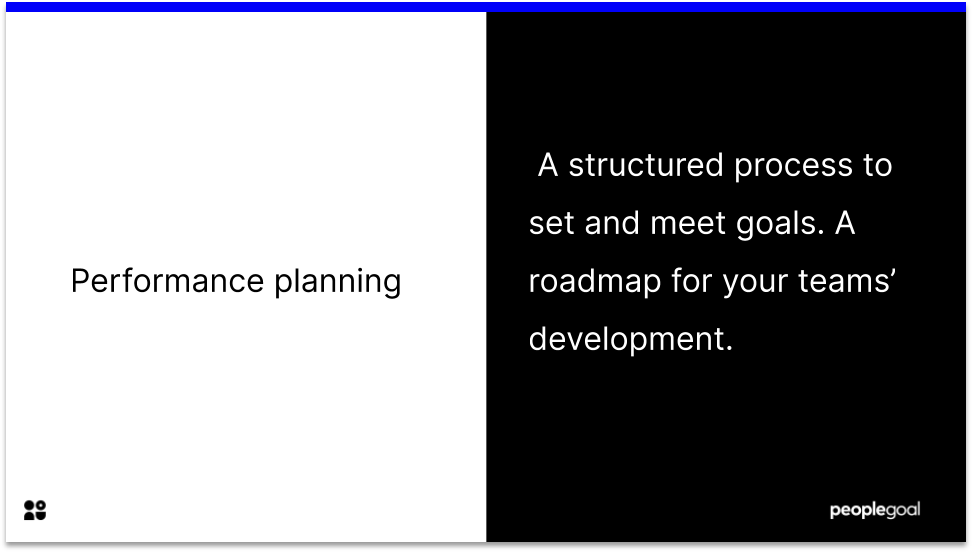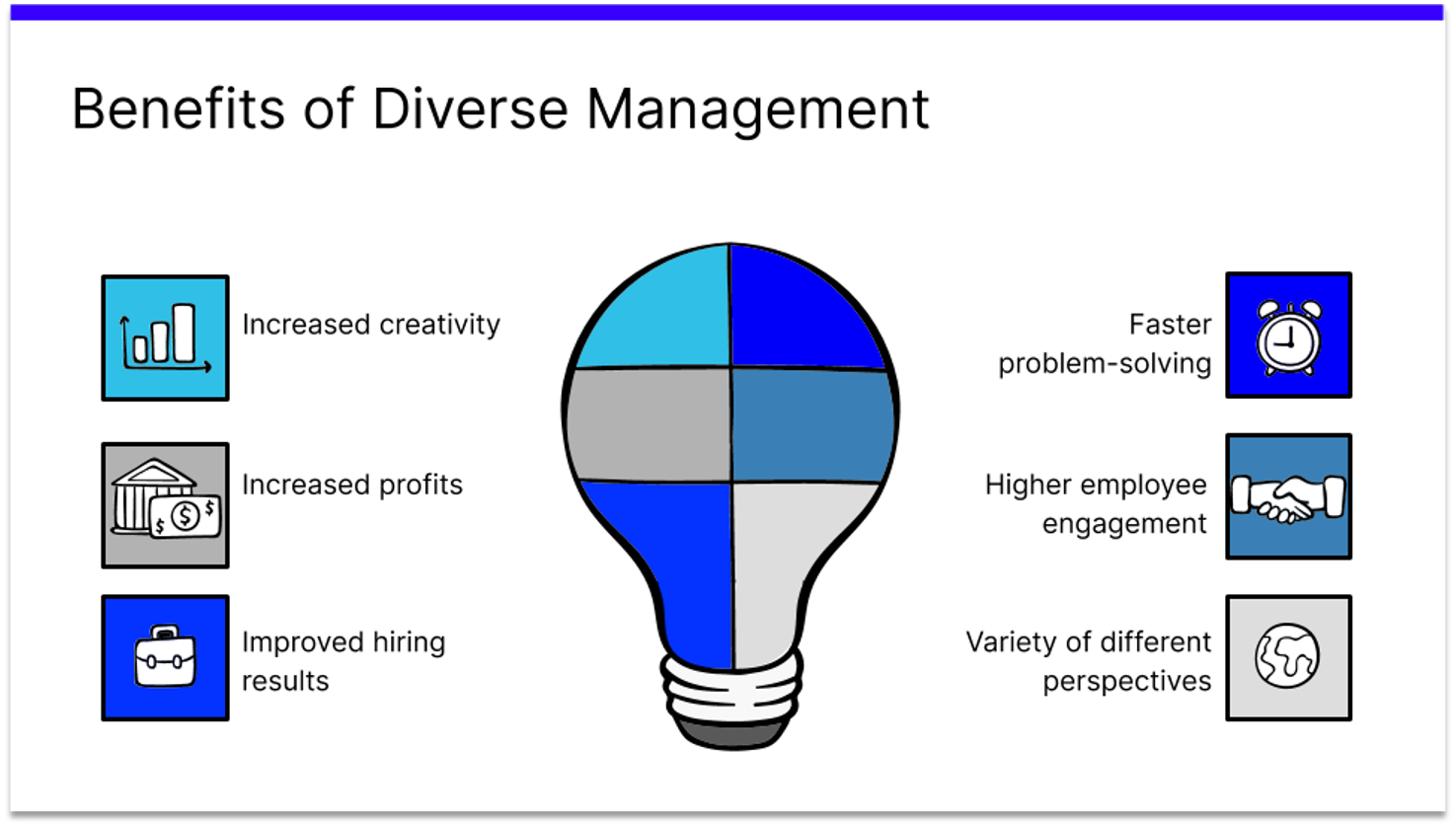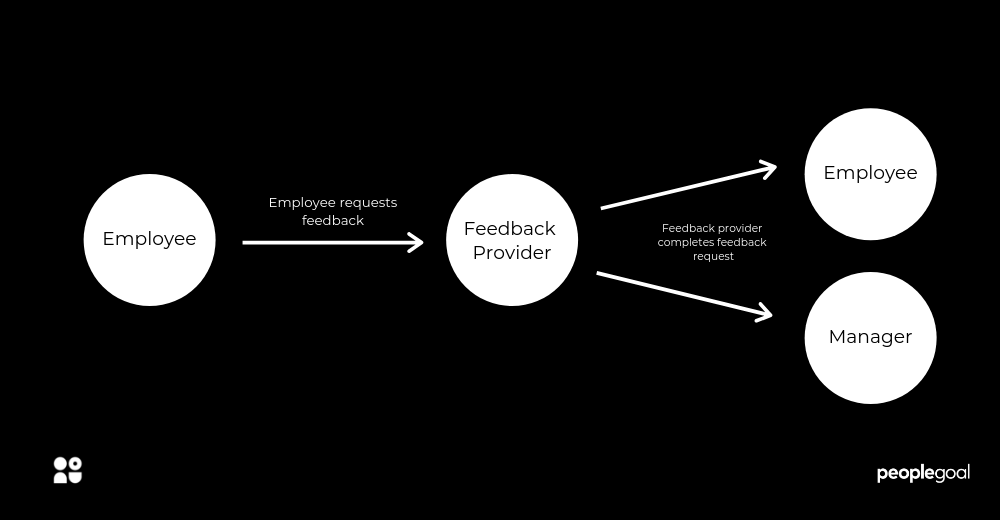Take clear goals, real-time feedback, and a good dose of employee engagement. Blend them together, and you’ve got the foundation for high employee performance.
But what’s the magic ingredient to bring it all together? A solid performance management software.
Having spent nearly a decade in talent acquisition and management, I’ve seen how organizations enhance employee performance through these tools. From automating reviews to boosting engagement, they’ve become indispensable for modern workplaces.
But with so many options, how do you choose the one that’s right for you? 🤔
Let me simplify the search with some of the best performance management system software to help you get started 🛠.
| Tool | Best Use Case | Starting Cost |
|---|---|---|
| PeopleGoal | Boosting Employee Performance & Improving Engagement | FREE 7-day trial. Paid starts at $4/user/month. |
| Lattice | HRIS in Large Enterprises | Starts at $10/seat/month. |
| PerformYard | Flexible Review Cycles | Starts at $5/candidate/month. |
| PeopleBox | OKR Management | Starts at $7/month/person. |
| BambooHR | Comprehensive HRIS With Payroll Solutions | Custom pricing. |
| Deel | Automated Payroll Support | Starts at $20/employee/month. |
| ClearCompany | Workforce Planning | Custom pricing. |
| 15Five | Enterprise Performance Reviews System | Starts at $4/user/month. |
| Small Improvements | Lightweight performance management and 360-degree feedback | Starting at $3/user/month. 30-day free trial. |
| Leapsome | Personalized Learning Paths | Custom pricing. |
What Is an Employee Performance Management System?
An employee performance management system (PMS) is a structured framework that organizations use to evaluate, track, and enhance employee performance. It combines goal-setting, continuous feedback, and periodic appraisals to ensure individual efforts align with company objectives.
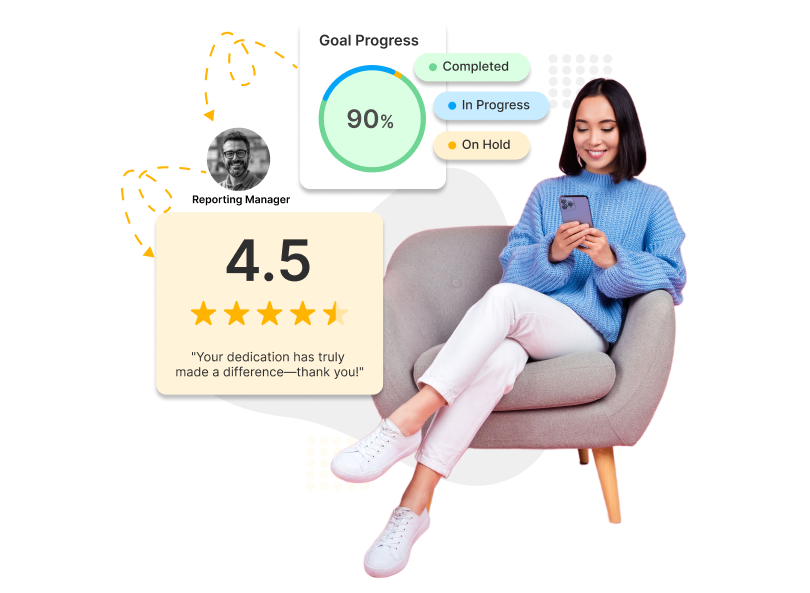
For example, imagine a sales team aiming to increase quarterly revenue. A PMS helps set targets, provides ongoing feedback to adjust strategies, and rewards top performers. This process motivates employees while ensuring the organization stays competitive.
It’s like having a coach for your business, guiding the team toward winning results.
According to a study, one-third of U.S. companies are abandoning the traditional appraisal process and switching to newer performance management systems.
Let’s check out the details of some software options in this aspect.
My Top 3 Performance Management Software Picks
If you wish to get a quick review of some of my favorite performance management systems, here are the top 3 tools I love:
PeopleGoal
If you’re looking for a tool that boosts both performance and engagement, PeopleGoal works well. It contains customizable workflows and templates that simplify performance tracking. The feedback system encourages growth, fostering a culture of continuous improvement. Plus, its engagement features, like recognition programs and pulse surveys, help keep team morale high.
BambooHR
BambooHR is a reliable and efficient performance management system that streamlines HR processes seamlessly. It combines core HRIS functionalities with payroll management, eliminating the need for multiple systems. From hiring to payroll, it’s user-friendly yet feature-packed, offering tools like time-off tracking, onboarding checklists, and payroll automation.
15Five
15Five transforms performance reviews into meaningful conversations. Its continuous feedback model keeps communication alive year-round, not just during review cycles. I loved how it promotes goal alignment while encouraging self-reflection for employees. Engagement surveys and pulse checks add extra value, helping teams stay connected and morale high.
Top 10 Employee Performance Management Software
Here’s a detailed review of the top performance management software in the market, along with their best features, pros, cons, and pricing, to help you better understand them.
1. PeopleGoal
Best for Boosting Employee Performance & Improving Engagement
If I had to pick one tool that genuinely focuses on employee performance and engagement, it’s PeopleGoal. It’s like the perfect blend of structure and motivation, helping teams perform better while staying genuinely connected.
It has customizable workflows and templates that make it easy to track performance metrics without overcomplicating things. Plus, the feedback system fosters continuous improvement, creating a culture where employees actually want to grow.
The engagement features are a cherry on top. You can set up recognition programs or pulse surveys to gauge team morale. Honestly, it’s one of those tools that doesn’t just measure performance but actively enhances it.
What You Will Like:
- The platform offers a wide range of templates for goal setting and 360-degree feedback processes.
- You can use OKRs, SMART goals & weekly tasks to ensure the team moves together in the same direction.
- It enables you to use check-ins, one-to-ones, and continuous feedback to assess and improve performance.
- You can leverage peer reviews and multiple-manager reviews to offer a well-rounded assessment of employee performance.
- The platform features a mobile-friendly interface and allows seamless integration with other HRIS tools.
What You May Not Like:
- No downloadable or on-premise version.
- The dark user interface option is not available.
Pricing: FREE 7-day trial. Paid starts at $4/user/month.
2. Lattice
Best for HRIS in Large Enterprises
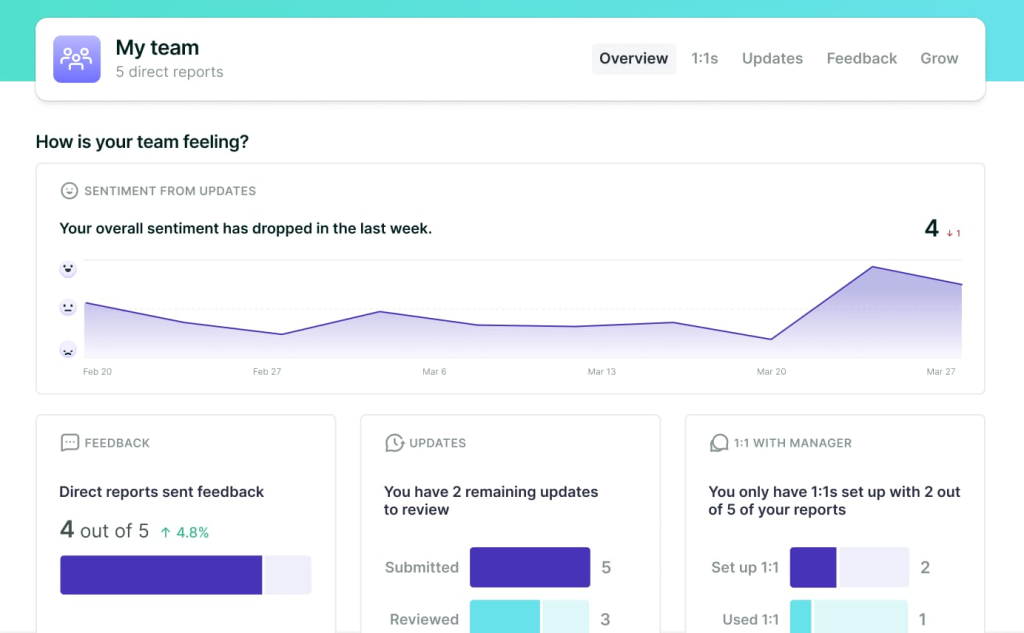
Lattice is one of the interesting continuous performance management software for enterprise-level HR needs. It’s like having a single control center to manage people and processes at scale.
A close friend who works in HR swears by its ability to integrate HRIS with performance management. The 360-degree feedback system, combined with in-depth analytics, makes it so much easier to track team dynamics and employee progress.
What stands out to me is how well it caters to the specific needs of large enterprises—whether it’s automating workflows or centralizing reviews for a giant workforce. And the OKR tracking? Absolutely clutch when you’re managing multiple departments.
What You Will Like:
- Lattice combines performance reviews, feedback, and employee engagement surveys into one comprehensive platform.
- Managers can easily schedule one-on-one meetings directly within the tool.
- A comprehensive analytics dashboard is provided for gaining real-time insights.
- Tools for continuous feedback and peer recognition are included to enhance collaboration.
- Lattice integrates seamlessly with popular collaboration tools such as Slack.
What You May Not Like:
- Notifications can become overwhelming, especially for larger teams.
- The entry-level plan offers limited features, which may not meet all needs.
Pricing: Starts at $10/seat/month.
3. PerformYard
Best for Flexible Review Cycles
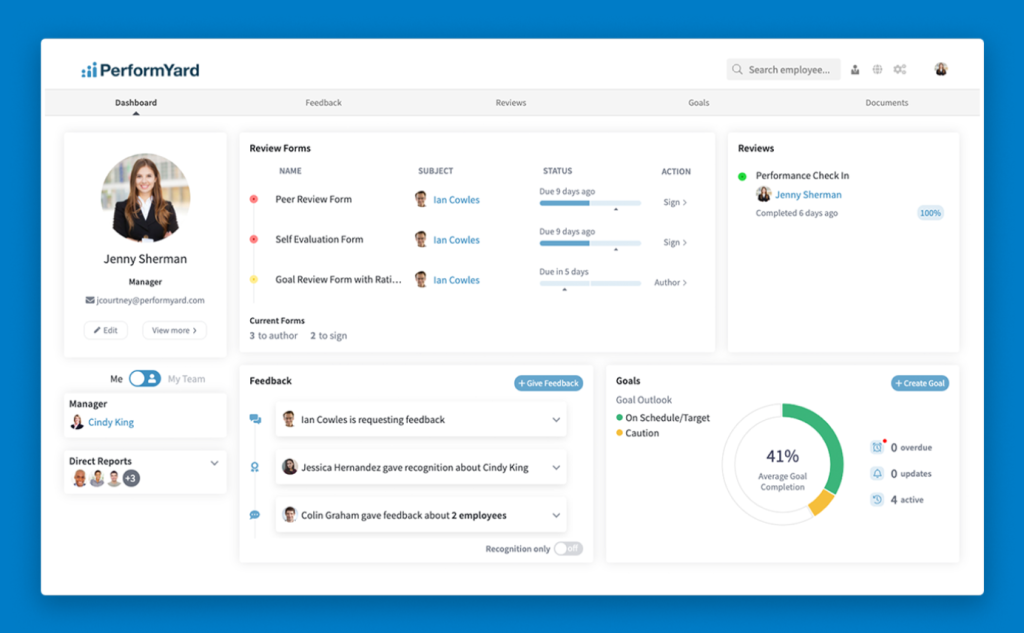
(Image Source: TechCrunch)
PerformYard is the go-to tool when your team’s review cycles don’t fit the cookie-cutter annual model. I’ve worked with teams that needed quarterly, project-based, or even ad-hoc reviews, and this tool handled it like a pro.
Its flexibility lets you create review schedules that match how your team actually works, not how someone else thinks they should. What I appreciate most is how seamlessly it combines structured feedback with goal alignment.
Managers can focus on coaching while employees get clarity on their growth trajectory. It’s performance reviews without the usual drama or dread.
What You Will Like:
- The software provides a centralized hub where all performance management activities can be managed efficiently.
- It includes tools for setting custom goals and tracking progress effectively.
- The platform enables 360-degree feedback to gather insights from multiple sources.
- Detailed analytics are available to help identify employee performance trends.
- Automated reminders and notifications simplify the review process for managers and employees.
What You May Not Like:
- Reporting capabilities may not meet the needs of organizations seeking advanced analytics.
- Customization options for feedback forms are somewhat limited.
Pricing: Starts at $5/candidate/month. Billed annually.
4. PeopleBox
Best for OKR Management
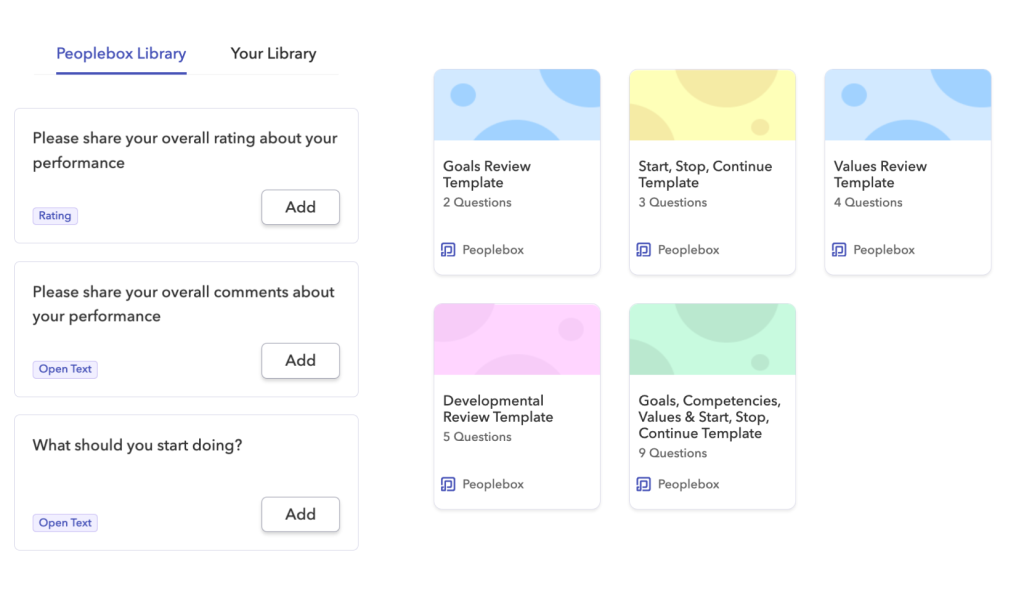
If you’ve ever struggled to manage OKRs efficiently, PeopleBox can be your savior. I’ve seen this staff performance management software in action with a friend’s startup, and it completely changed how their team tracked progress.
What makes it special is how it connects individual OKRs to team and company goals, creating this seamless alignment across the board. The platform also doubles as a coaching tool, giving managers insights into how their teams are performing against objectives.
And it’s not just about tracking—it actively drives accountability with reminders and check-ins.
Bonus? The engagement features, like employee feedback tools, make it feel more human.
What You Will Like:
- The platform offers tools for real-time feedback and performance tracking to boost productivity.
- Analytics capabilities are powerful, making it easier to identify high-performing teams and areas for improvement.
- Automated reminders for goal reviews and check-ins keep everyone on track without manual follow-ups.
- Customizable dashboards simplify the process of aligning team objectives.
- The mobile app ensures that remote teams have easy access to performance data.
What You May Not Like:
- Advanced features often require additional setup, which can be time-consuming.
- The platform offers limited integrations compared to some larger competitors.
Pricing: Starts at $7/month/person. Billed annually.
5. BambooHR
Best for Comprehensive HRIS With Payroll Solutions
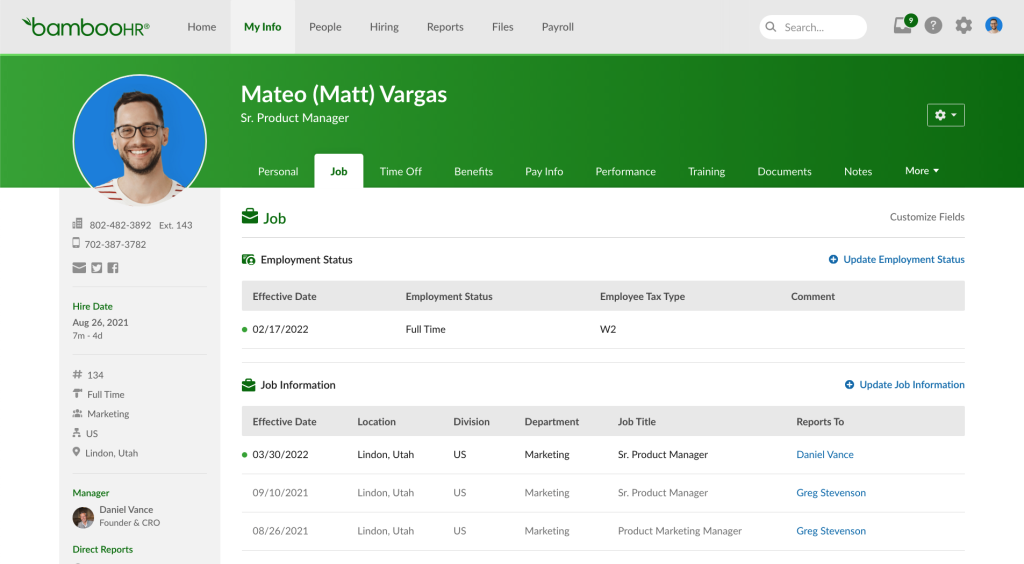
(Image Source: People Managing People)
BambooHR is one of the best HR performance management software I have worked with. It is efficient, organized, and always on top of things. I used it during a project that required streamlining HR processes, and it handled everything from hiring to payroll without breaking a sweat.
What’s impressive is how well it integrates core HRIS functionalities with payroll management, so you’re not juggling two systems. It’s user-friendly but still packed with powerful features, like detailed employee records, time-off tracking, and even onboarding checklists.
The payroll automation is also quite good; it’s accurate, timely, and stress-free. You can give employees more autonomy with self-service options, which is always a win.
What You Will Like:
- The software provides tools for tracking goals and generating detailed performance reports.
- Employee self-assessment features encourage active participation in the review process.
- Robust data security measures are in place to protect sensitive employee information.
- Integrated workflows make onboarding and performance management more streamlined.
- The platform includes customizable templates for conducting performance reviews effectively.
What You May Not Like:
- Performance management features are only accessible in higher-tier plans, limiting availability for some users.
- The mobile app offers limited capabilities for setting and tracking goals.
Pricing: Custom pricing.
6. Deel
Best for Automated Payroll Support
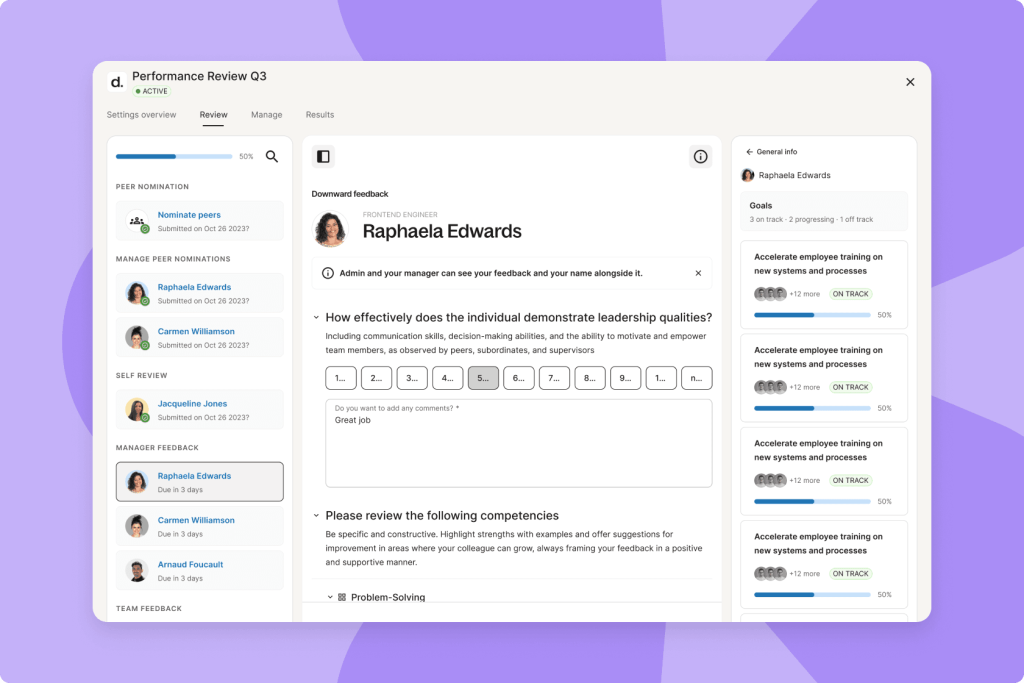
Managing payroll for a global workforce?
Deel is your secret weapon.
A colleague running an international business uses this and he is so impressed by how it simplifies payments across countries, currencies, and tax systems.
What I love about Deel is that it takes care of compliance, too, so you’re not stuck Googling international labor laws. The automated payroll feature is a huge time-saver—set it up once, and it does the heavy lifting for you.
Plus, it’s tailored for remote teams, handling contracts, benefits, and even local tax filings effortlessly.
What You Will Like:
- Real-time feedback and goal-setting tools help to keep employees aligned and motivated.
- The platform simplifies onboarding processes for remote teams across different countries.
- Customizable workflows for performance reviews add flexibility to the management process.
- Detailed reports are available to track employee growth and performance metrics.
- It supports a good mobile app that ensures global teams can stay connected and access performance tools anywhere.
What You May Not Like:
- Full onboarding requires a significant time investment for effective implementation.
- Some users report occasional glitches in the mobile app, affecting usability.
Pricing: Starts at $20/employee/month.
7. ClearCompany
Best for Workforce Planning
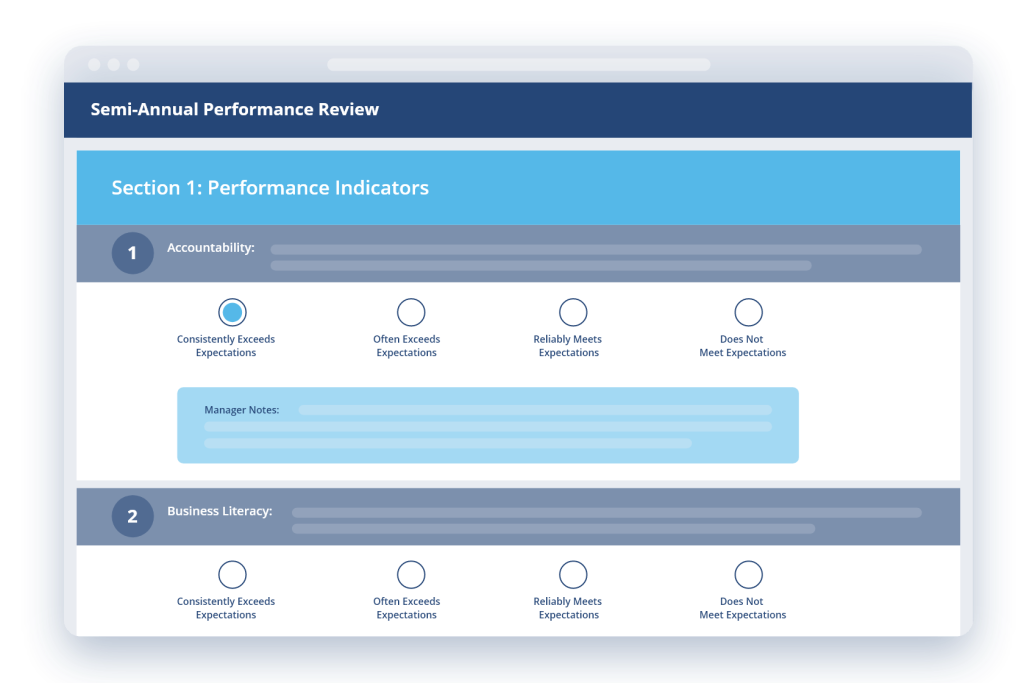
ClearCompany is one of those tools that makes workforce planning feel less like a guessing game and more like an art.
A former manager introduced me to it, and I remember being amazed at how intuitive the talent forecasting features were. It’s perfect for organizations that want to align their hiring strategy with long-term goals.
The performance management tools are equally impressive, offering actionable insights into team dynamics and individual productivity.
And the talent management system? I love how it helps you identify top performers and plan for succession like a pro.
What You Will Like:
- The software includes tools for aligning goals and offering continuous feedback.
- Pre-built templates are available to simplify the performance review process.
- Detailed analytics help organizations assess performance trends and make informed decisions.
- Customizable workflows allow companies to adapt the platform to their unique requirements.
- The platform integrates with popular HRIS tools, ensuring seamless data management.
What You May Not Like:
- Initial setup can be time-intensive and may require additional training.
- Reporting capabilities may not meet the needs of organizations requiring highly complex analytics.
Pricing: Custom pricing.
8. 15Five
Best for Enterprise Performance Reviews System
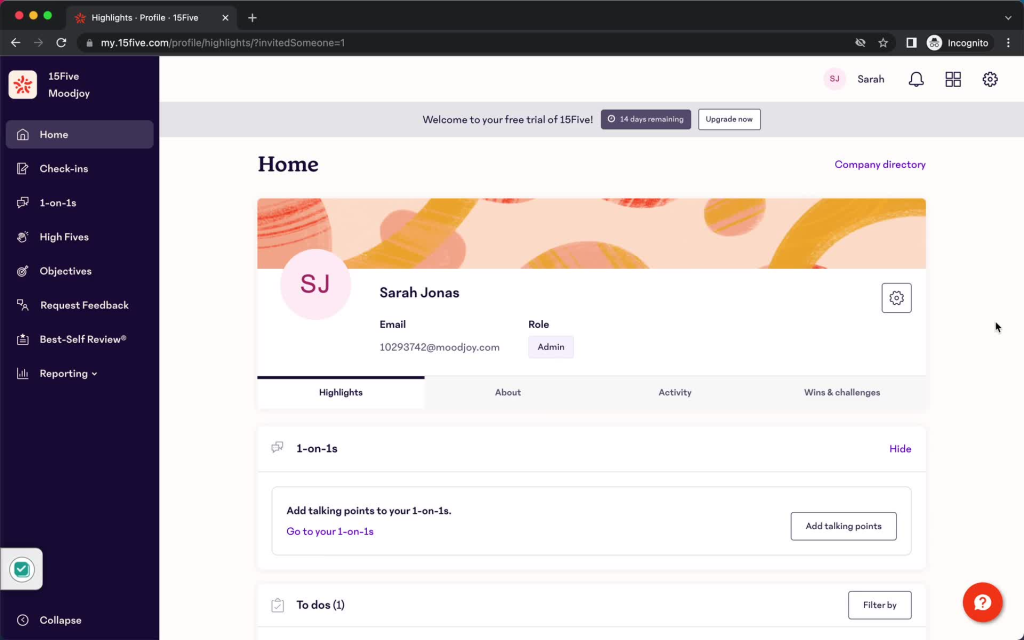
15Five is one of those tools that makes performance reviews actually feel meaningful. I’ve personally used it in one of my earlier organizations, and it stood out for how well it scales.
The continuous feedback model keeps conversations going throughout the year instead of just once or twice. I loved how the tool encourages goal alignment while giving employees the spotlight for self-reflection.
The best part is that managers get a clear roadmap for one-on-ones, making discussions more productive and less awkward. It’s also packed with features like engagement surveys and pulse checks, which make it easier to gauge team morale.
What You Will Like:
- Weekly check-ins are available to track employee sentiment and resolve issues promptly.
- The platform includes tools for managing OKRs and tracking goals effectively.
- Coaching tools are provided to help managers support and develop their teams.
- Analytics tools offer insights into engagement trends and areas for improvement.
- Integration with collaboration tools like Slack enhances usability and accessibility.
What You May Not Like:
- The pricing structure may not suit smaller organizations with limited budgets.
- The mobile app offers limited functionality for conducting performance reviews.
Pricing: Starts at $4/user/month. Billed annually.
9. Small Improvements
Best for lightweight performance management and 360-degree feedback
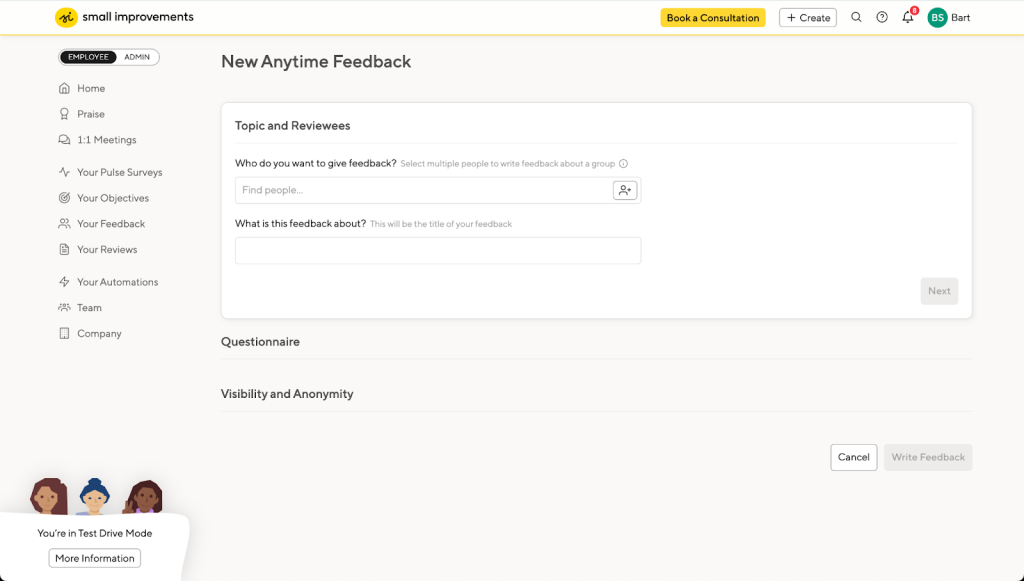
If you’re looking for performance management software that doesn’t feel like enterprise software, Small Improvements is worth a look. It helps teams run reviews, 360s, and track objectives in a way that feels light and flexible.
It’s not about rigid processes but about creating space for managers and employees to connect. HR still gets visibility, but without the friction you often find in heavier systems.
What You Will Like:
- Lightweight reviews and 360s with flexible templates
- Continuous feedback and shared 1-on-1 agendas
- Simple objectives tracking that doesn’t require full OKRs
What You May Not Like:
- Not built for advanced OKR mapping
- Analytics are lighter than enterprise tools
Pricing: Starting at $3/user/month. 30-day free trial.
10. Leapsome
Best for Personalized Learning Paths
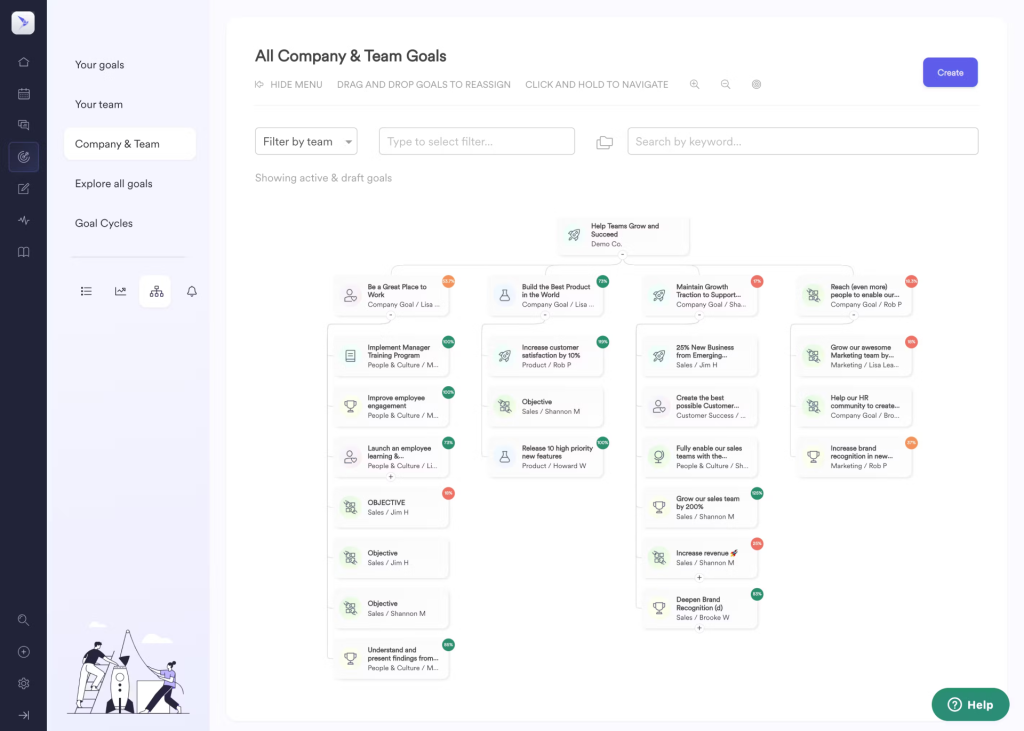
(Image Source: Software Advice)
Leapsome is an awesome software for performance management if you’re looking to combine performance management with employee development.
A friend in L&D uses it, and she loves how it helps tailor learning paths based on individual goals and performance metrics.
What’s cool is how seamlessly it integrates feedback, OKRs, and development plans into one cohesive system. The personalized learning paths it supports are not just about skill-building but also fostering long-term growth.
It’s like having a custom-built career roadmap for every team member. And even the analytics are pure gold for identifying trends and areas for improvement.
What You Will Like:
- It combines performance reviews, engagement surveys, and OKRs into one comprehensive platform.
- Tools for continuous feedback and coaching are included to encourage ongoing development.
- The platform supports customizable review workflows to meet diverse organizational needs.
- 360-degree feedback capabilities offer a holistic view of employee performance.
- The software integrates with popular HR tools, enhancing overall usability.
What You May Not Like:
- Customization options may require technical expertise for effective implementation.
- Offline functionality is limited, which can be a challenge for some users.
Pricing: Custom pricing.
Evaluation Criteria
The evaluation of the performance management systems listed in this article is based on a detailed, methodical approach designed to offer an honest, well-rounded perspective. Here’s how I assessed each tool:
- User Feedback & Ratings
Real-world feedback from actual users, sourced from trusted review platforms, plays a key role. These insights shed light on strengths, pain points, and overall user satisfaction, offering a ground-level understanding of the tools. - Features That Matter
A product is only as good as its features. I focused on the core functionalities that directly impact performance management—think goal tracking, feedback systems, and analytics. Tools that go the extra mile to simplify workflows and enhance productivity got a closer look. - Ease of Use
It doesn’t matter how powerful a tool is if it’s frustrating to use. I evaluated the intuitiveness of navigation, setup processes, and how well each platform caters to users across different experience levels. - Customer Support
From onboarding to troubleshooting, solid customer support can make or break the user experience. I explored the quality, responsiveness, and helpfulness of support teams, along with available resources like help centers or training materials. - Value for Investment
Performance management tools can be a significant investment, so understanding the value proposition is critical. I assessed whether the features, performance, and support justify the cost for both small businesses and larger organizations. - Personal Insights & Expert Opinions
Beyond the numbers and ratings, I brought in my hands-on experience and consulted opinions from HR and performance management professionals. This mix of personal anecdotes and expert insights adds depth and relatability to the evaluation.
How to Implement the Right Performance Management System
A robust performance management system ensures alignment between organizational goals and individual efforts, fostering productivity and growth.
Here’s a step-by-step guide to implementing a system that truly delivers:
1. Define Clear Objectives and Goals for Better Planning
“Clarity is the foundation of success.”
A strong PMS begins with setting clear, actionable goals that align with the company’s mission. Using the SMART framework—Specific, Measurable, Achievable, Relevant, and Time-bound—ensures employees understand what’s expected and can work toward a shared vision.
This not only drives focus but also helps teams prioritize their efforts effectively.
Example: Google’s OKR (Objectives and Key Results) system is widely acclaimed for its effectiveness. If a goal is “Improve website speed,” the key result might be “Reduce average load time from 5 seconds to 3 seconds,” providing clear direction for developers.
2. Involve Stakeholders in Design to Foster Ownership
“Collaboration breeds commitment.”
A performance management system designed with input from employees, managers, and HR creates a sense of shared ownership.
When stakeholders contribute to employee development, the system is more likely to address real challenges, gain support, and meet everyone’s expectations. Plus, people are naturally more committed to what they help create.
Example: Netflix engaged cross-functional teams to co-create its culture-defining “Feedback Framework.” This approach led to the adoption of informal, continuous feedback sessions, making the system both practical and people-friendly.
3. Use Technology for Efficiency and Transparency
“Streamline processes, boost productivity.”
Technology takes the guesswork and paperwork out of performance management. Modern tools simplify goal tracking, automate feedback collection, and generate performance analytics, leaving managers and employees free to focus on what truly matters: improvement and innovation.
Example: Salesforce uses its in-house platform to track individual and team performance in real time. With easy-to-read dashboards and automated reports, employees and leaders can stay on top of progress without extra administrative burdens.
4. Provide Regular Feedback and Coaching to Inspire Growth
“Feedback is the breakfast of champions.”
Annual reviews often come too late to be effective. Frequent, constructive feedback ensures employees have the opportunity to correct course, improve skills, and celebrate achievements in real-time.
Coupled with coaching, this approach helps employees grow while keeping them engaged and motivated.
Example: General Electric (GE) implemented “PD@GE,” a mobile app for continuous performance development. Employees and managers exchange real-time feedback, creating a dynamic and supportive work environment.
5. Ensure Fairness and Transparency to Build Trust
“Fair play builds lasting trust.”
A PMS must be fair and unbiased, applying consistent criteria for evaluating performance. Transparency in the process, how goals are set, feedback is given, and decisions are made, builds employee trust and reinforces the system’s credibility.
Example: Adobe’s “Check-Ins” replaced traditional annual appraisals with open discussions about performance, progress, and goals. The transparent process makes employees feel heard and ensures a fair evaluation system.
6. Integrate Learning and Development to Bridge Skill Gaps
“Grow talent, grow the organization.”
Performance management should identify opportunities for skill enhancement and provide solutions through training, certifications, or mentorship. This investment in learning not only equips employees to excel but also strengthens the organization’s capabilities.
Example: Amazon’s “Career Choice” program funds employees to acquire skills for future roles, demonstrating a commitment to their long-term development while addressing evolving business needs.
7. Foster a Culture of Recognition to Boost Morale
“A little praise goes a long way.”
Employee recognition isn’t just about applause—it’s about reinforcing positive behavior and encouraging excellence. Whether it’s a quick “thank you” in a meeting, a performance bonus, or a formal award, recognition motivates employees and promotes a sense of belonging.
Example: Starbucks’ “Bean Stock” program rewards employees with company shares, turning their hard work into tangible equity and fostering a sense of pride and ownership.
8. Adapt the System to Evolving Needs for Continued Relevance
“Change is constant—stay ahead of it.”
Performance management software must be flexible enough to evolve with the organization. Regular reviews ensure that the system remains aligned with shifting business priorities, technological advancements, and employee expectations. Keeping the system agile ensures that it continues to deliver value.
Example: Microsoft transitioned from its outdated “stack ranking” system to a modern, growth-oriented approach. This evolution emphasized collaboration and adaptability, keeping the company competitive in a fast-changing tech landscape.
Which Is the Best Performance Management Software?
Picking the best performance management software depends on your organization’s unique goals and needs. Each tool offers a mix of features to enhance employee engagement, streamline evaluations, and drive productivity.
Explore your options and align them with what matters most—be it flexibility, analytics, or ease of use.
Personally, I’ve found PeopleGoal impressive for its clear goal-setting features, customizable review templates, and intuitive progress tracking. It’s like having a performance booster built right into your workflow!
But whichever you choose, ensure it empowers your team to thrive and grow. After all, great tools inspire even greater results!
Learn More About Performance Management Systems
What are the key features to look for in a performance management system?
A good performance management system should include goal-setting tools, real-time feedback, and employee development features. Look for customizable performance reviews, analytics for tracking progress, and integration with other HR tools. Automated reporting and a user-friendly dashboard make managing processes smoother. Also, prioritize systems with 360-degree feedback and clear metrics to evaluate performance. These features ensure a robust and efficient system for employee performance evaluation.
Why should you look for performance management software?
Performance management software streamlines evaluations, ensuring consistency and reducing bias. It simplifies goal tracking, aligns team objectives with company goals, and provides real-time performance data. Automated reminders and reports save time, allowing managers to focus on development. The software also fosters employee engagement by facilitating constructive feedback and identifying growth opportunities. Overall, it improves the organization’s transparency, productivity, and accountability, making it a valuable investment.
What are common performance management system mistakes?
Common performance management system mistakes include unclear goals, infrequent feedback, and overcomplicated processes. Relying solely on annual reviews instead of continuous assessments can lead to disengagement. Besides, the lack of employee training in using the system reduces its effectiveness. Also, poor communication during evaluations or failure to address employee concerns creates mistrust, and overemphasizing weaknesses instead of strengths can demotivate employees.
What are successful performance management system strategies?
Successful strategies include setting clear, measurable goals aligned with organizational objectives and offering regular feedback instead of annual reviews. Encourage employee involvement in the goal-setting process to boost engagement. Use data-driven insights to guide performance discussions and identify development opportunities. Recognize achievements to foster motivation and provide training to improve skills. Regularly review and update the system to adapt to changing organizational needs.
What are the types of performance management systems?
Performance management systems can be broadly categorized into five types:
- Traditional systems: Focus on annual reviews.
- 360-degree feedback systems: Collect input from multiple sources.
- Competency-based systems: Assess specific skills and abilities.
- OKR (Objectives and Key Results) systems: Track goal progress effectively.
- Continuous performance systems: Emphasize ongoing feedback and real-time tracking.
Ready to 3x Your Teams' Performance?
Use the best performance management software to align goals, track progress, and boost employee engagement.
